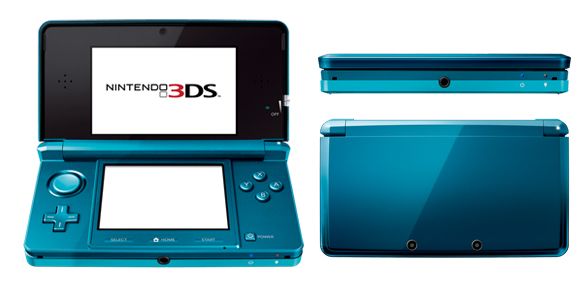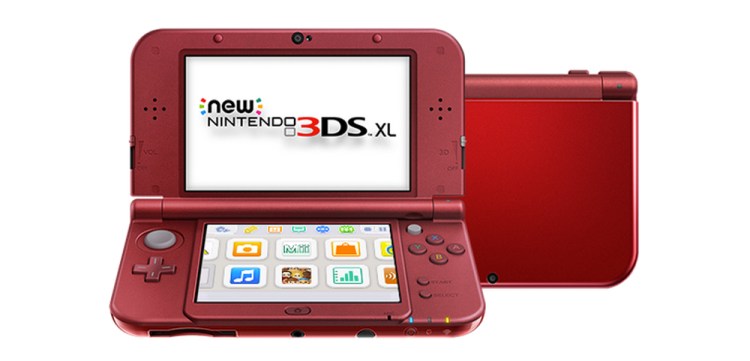Last weekend saw the U.S. release of Nintendo’s latest handheld console, the New 3DS XL, and it does two things. First, it includes a faster processor, a little nub that can function as the second analog stick that fans and developers have been asking for since the original 3DS launched in 2011, and it provides a wider viewing angle for its centerpiece 3D graphics.
Secondly, it continues the developer’s tradition of iterating on its hardware to correct previous models’ shortcomings. To be fair, Sony and Microsoft have also done this, with the former redesigning its PlayStation Portable handheld three times and the latter creating a new Xbox 360 that promised to be immune to the dreaded “Red Ring of Death” hardware failure that plagued early models.
But neither of them has anything on Nintendo’s 25 years of iteration on its portables. Here’s a brief history of the company’s hardware flaws and subsequent corrections.
Game Boy (1989)

Above: The original is still one of the best. Especially because you could play Tetris on it.
The original Game Boy was amazing. I’d grown up with crappy Tiger Electronics handhelds, so the idea that I could play real games with animations and levels and such pretty much changed my life. It was kind of clunky and had its famous pea soup-colored graphics, but it was a start. And I played so much Tetris on that thing that it ultimately didn’t matter what color the blocks were.
Still, Nintendo knew it could do better, and so we got:
Game Boy Pocket (1996)
The green screen remained on this updated model, but it was smaller and lighter. But the original Pocket inexplicably eliminated the Power indicator of the original, so the second version (released in 1997) restored this function.
Despite these tweaks, however, a major flaw remained: You couldn’t really see the screen in low light. I had a peripheral for that first console called the Game Light that slid on the top to put a little illuminated frame over the screen, but other companies thought they’d solve every problem simultaneously.
Check out the Handy Boy by STD, which includes a light, a screen magnifier, stereo speakers, and extensions for both your directional pad and buttons. It also came with a shoulder strap, presumably because you’d need a little help holding that thing up while you were playing it.
But that’s not to say that I didn’t want the hell out of it.

Above: Look — this is what passed for “awesome” when I was a kid.

Above: Congrats, Japan!
Game Boy Light (1998)
Nintendo saw the demand for a backlit screen, and it acted … by releasing a lighted version of the Game Boy Pocket exclusively in Japan. So that was pretty cool for importers and Japanese folks, but the rest of the world had to wait another six months.
Game Boy Color (1998)
Finally, the new generation of Game Boy appeared. And it still didn’t light up, damn it. But it did finally bring color (other than green) to portable Nintendo gaming along with a processor that was about as powerful as the original Famicom/Nintendo Entertainment System from 1985. But you could easily take it with you, so that was way better.
The Game Boy Color also played just about every Game Boy cartridge ever made, so it launched with a library big enough to almost make up for the fact that you kinda needed to shine a flashlight on it to see.
And so the time of the original portable came to an end, but Nintendo still had plenty to do. Thus, we entered the era of the Advance.

Above: This is also where the “Is that the only color you have?” incidents began.
Game Boy Advance (2001)
The Game Boy Advance was a beast. It was bigger, faster, button-ier, and more see-through than any Game Boy released up to that point. OK, so you could also see through the Game Boy Color’s case, but the Advance just had more to see under there. Chips and stuff. Where the graphics come from.
And what else did the Advance have in common with its predecessors? You still couldn’t see the damned screen unless you played it inside the Well-Lit Room from the end of Alan Wake.

Above: Alright. Now you can play Mario Kart.
The Advance also had a fairly awkward shape that wasn’t likely to fit into too many pockets, so it was the first portable system that kind of demanded you save some space in your backpack.
Game Boy Advance SP (2003)
Two years later, Nintendo released the Game Boy Advance SP, an update so dramatic that it was hard to tell that the two GBAs were even related.
The SP was small, and it folded up into an adorable little square that you could carry around with ease. It was also the first Game Boy that came with an internal rechargeable battery and, finally, a front-lit screen. A later, smaller update swapped in a backlight, but I’m not sure any of the early adopters complained too much about the added visibility.

Above: The awesome SP (right) and the less-so Game Boy Advance (images not to scale).
You know what they probably did complain about, though? The fact that the SP did not have a standard headphone jack in it, and you had to buy a proprietary adapter from Nintendo to get your earbuds to work.
Oh, Nintendo.
Game Boy Micro (2005)
The third GBA — and the final thing called “Game Boy” — is more of a footnote than anything else, neither addressing nor introducing any significant design issues. It remains the smallest handheld the company has ever made, with a design slightly smaller than an iPhone, and it did not have the backward compatibility with original Game Boy cartridges that the earlier GBAs had.
It was just kind of this cool little thing that happened, and then we moved on.

Above: D’awwwww.

Above: Bring forth all of the screens.
Nintendo DS (2004)
The first DS was supposed to exist alongside the Game Boy Advance instead of replacing it, but it could play all of the games for the earlier system, so fans didn’t see a whole lot of reason to go back and forth between them.
It was cool; it had 100 percent more screens than any Nintendo handheld previously released, and one of them was touch-sensitive. It also had a microphone, and you could use Wi-Fi to play local multiplayer. And it had a big slot for Game Boy Advance cartridges, so that was also cool. Sure, it was a bit bulky, but apparently nobody cared because it sold like crazy.

Above: The Lite was more square than the DS, but not as square as the GBA SP.
Nintendo DS Lite (2006)
Of course, Nintendo wanted to streamline its latest gadget, so two years after the original console, we got this tiny-fied version that was smaller, more rectangular, and had a brighter screen. It didn’t quite have the adorable design of the Game Boy Advance SP, but it was pretty darn cute.
And then, things just got kind of silly.
Nintendo DSi (2008, worldwide in 2009)
The DSi was a larger version of the Lite that adds two halfway decent cameras and a bigger screen. It also removed the GBA slot, which meant that not only could gamers no longer play Game Boy Advance titles on it, but nor could they play select DS games that used that slot for peripherals. This would be things like Guitar Hero: On Tour, which carried most of its controls on an external gadget so that the screen was free for strumming.
OK, so maybe that wasn’t a huge loss, all told.
Nintendo DSi XL (2009)
A pattern has emerged here: A thing comes out, and then Nintendo makes a smaller version. That’s how it went for 20 years. But then, the developer said, “Let’s do the complete opposite of that.” And so we have the Nintendo DSi XL (LL in Japan), which had all of the same features of the DSi but in much greater proportion. The batteries lasted longer, the screens were twice the size, the viewing angle was wider, and the incidence of hand cramps in grown men trying to enjoy the Professor Layton series plummeted.

Above: The Nintendo DSi XL: now for grown-up hands.
It also came with a stylus the size of a fountain pen, and that was probably my favorite part of this hardware.
Nintendo 3DS (2011)
We’re almost caught up now with the release of the latest family of systems. The 3DS featured glasses-free 3D gameplay on its top screen and was backward compatible with original DS titles (although you could not get the cool visual effects on them). It introduced a slew of new online features like the friend-making StreetPass, an Internet browser, and compatibility with Nintendo’s Virtual Console, which allows you to purchase and play classic titles on the go.

Above: They made it shiny so that you’d want it. It still took a little while.
Because it was the first in the series, however, it had problems. In order to see the 3D images on the top screen, you had to maintain a proper distance, and the viewing angle was ridiculously small. It also lacked the second analog stick necessary to effectively play first-person shooters and other titles that benefit from giving players full control of the in-game camera.
Nintendo responded to this last issue by introducing the Circle Pad Pro, a cradle that adds another analog control on the right side as well as a few extra shoulder buttons. But players would have to wait to get that functionality built into the system itself.
Nintendo 3DS XL (2012)
In fact, they would even have to wait longer than the introduction of the supersized 3DS XL (LL once again in Japan) the following year. This plus-sized iteration had a screen almost twice as large as the original 3DS with the slight drawback that it displayed in the same resolution, so the graphics weren’t quite as crisp.
And yes, Nintendo made a larger Circle Pad Pro just for it.

Above: Guess it wasn’t big enough.
Nintendo 2DS (2013)

Above: It’s slightly less uncomfortable to hold than it looks. Slightly.
The 2DS was a bit of hardware that nobody either expected or really asked for, but it was an interesting experiment.
Nintendo created it as a budget-priced product for college kids who were low on money but still wanted to play Pokémon and for young children whose eyes were not sufficiently developed to handle the 3D graphics of its older siblings (it only displays games in 2D). It was kind of a modern version of the Micro, only it was less portable than the old models and had poorer sound quality.
And now, we’ve received the New Nintendo 3DS XL, which fixes both the 3D graphics and the second-analog problems. So we should be all set until the developer unveils its next generation of handhelds, which history says will be both incredibly exciting and somewhat flawed.
But don’t worry, currently unannounced gaming device: They’ll fix you. They fix everything.
VentureBeat's mission is to be a digital town square for technical decision-makers to gain knowledge about transformative enterprise technology and transact. Learn More

